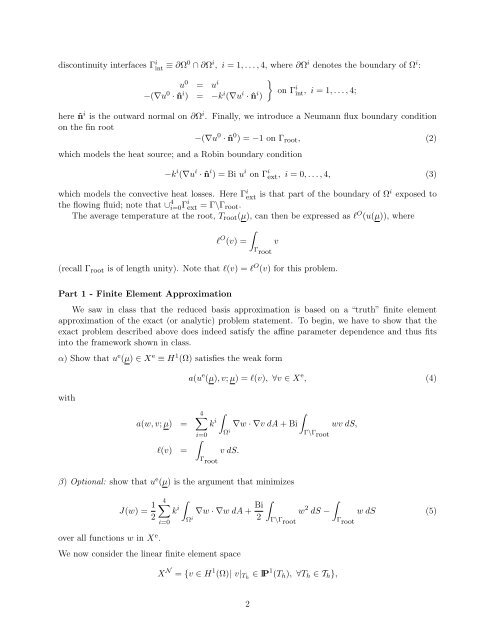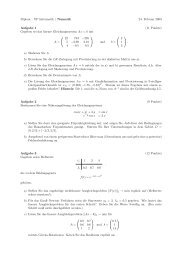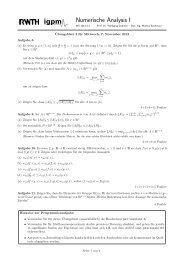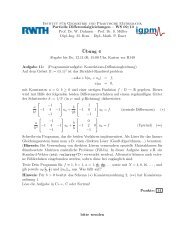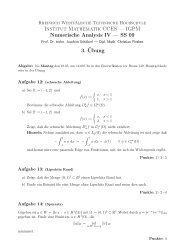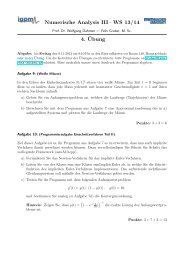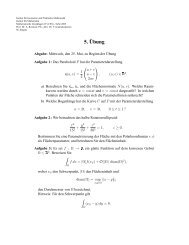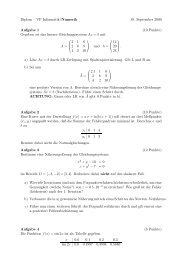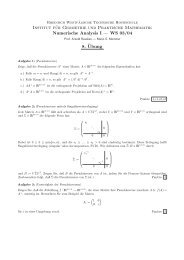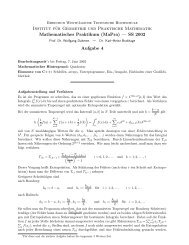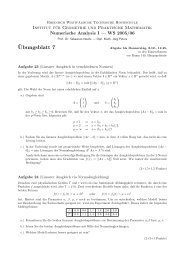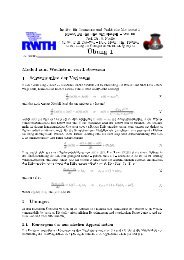The Reduced Basis Method Problem Set 1
The Reduced Basis Method Problem Set 1
The Reduced Basis Method Problem Set 1
Create successful ePaper yourself
Turn your PDF publications into a flip-book with our unique Google optimized e-Paper software.
discontinuity interfaces Γ i int ≡ ∂Ω0 ∩ ∂Ω i , i = 1, . . . , 4, where ∂Ω i denotes the boundary of Ω i :<br />
u 0 = u i<br />
−(∇u 0 · ˆn i ) = −k i (∇u i · ˆn i )<br />
}<br />
on Γ i int, i = 1, . . . , 4;<br />
here ˆn i is the outward normal on ∂Ω i . Finally, we introduce a Neumann flux boundary condition<br />
on the fin root<br />
−(∇u 0 · ˆn 0 ) = −1 on Γ root , (2)<br />
which models the heat source; and a Robin boundary condition<br />
−k i (∇u i · ˆn i ) = Bi u i on Γ i ext , i = 0, . . . , 4, (3)<br />
which models the convective heat losses. Here Γ i ext is that part of the boundary of Ωi exposed to<br />
the flowing fluid; note that ∪ 4 i=0Γ i ext = Γ\Γ root.<br />
<strong>The</strong> average temperature at the root, T root (µ), can then be expressed as l O (u(µ)), where<br />
∫<br />
l O (v) = v<br />
Γ root<br />
(recall Γ root is of length unity). Note that l(v) = l O (v) for this problem.<br />
Part 1 - Finite Element Approximation<br />
We saw in class that the reduced basis approximation is based on a “truth” finite element<br />
approximation of the exact (or analytic) problem statement. To begin, we have to show that the<br />
exact problem described above does indeed satisfy the affine parameter dependence and thus fits<br />
into the framework shown in class.<br />
α) Show that u e (µ) ∈ X e ≡ H 1 (Ω) satisfies the weak form<br />
a(u e (µ), v; µ) = l(v), ∀v ∈ X e , (4)<br />
with<br />
a(w, v; µ) =<br />
l(v) =<br />
4∑<br />
∫<br />
k i ∇w · ∇v dA + Bi wv dS,<br />
i=0<br />
∫Ω i Γ\Γ root<br />
∫<br />
v dS.<br />
Γ root<br />
β) Optional: show that u e (µ) is the argument that minimizes<br />
J(w) = 1 2<br />
4∑<br />
∫<br />
k i<br />
i=0<br />
∇w · ∇w dA + Bi<br />
Ω i 2<br />
∫<br />
Γ\Γ root<br />
∫<br />
w 2 dS − w dS (5)<br />
Γ root<br />
over all functions w in X e .<br />
We now consider the linear finite element space<br />
X N = {v ∈ H 1 (Ω)| v| Th ∈ IP 1 (T h ), ∀T h ∈ T h },<br />
2


